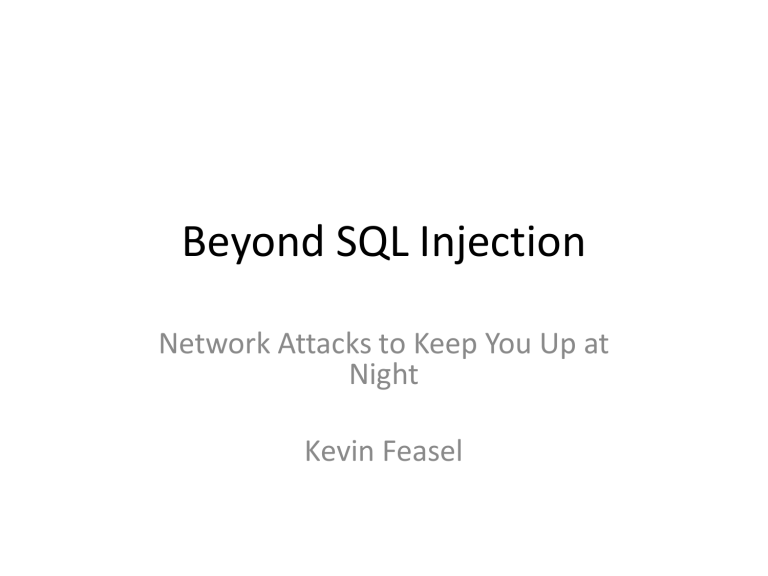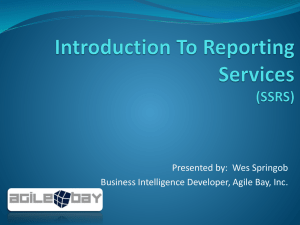Beyond SQL Injection - Columbus SQL Server User Group

Beyond SQL Injection
Network Attacks to Keep You Up at
Night
Kevin Feasel
Who Am I? What Am I Doing Here?
• Database Administrator
– SQL Server DBA
– SSIS developer
– Currently working for Aetna
• Standard employer disclaimer
– Catallaxy Services
• http://www.catallaxyservices.com
• Security Nut
• Cyclist
• Occasional world traveler
Protecting That Which Is Yours
• DBAs are data stewards: we protect the data
• How far should we go to protect it?
• What about the really important stuff?
Protecting The Data: The Basics
• Logins have strong passwords
• Follow least privilege for accounts
• Use roles and groups to create database access control list (ACL)-like substances
• Track login failures (and successes?)
• Encrypt databases which require encryption
• Encrypt and securely store backups
• Protect against SQL injection in code
Moving Beyond The Basics
• Key assumption: your organization already handles the basics fairly well
– If not, I know of a tax shelter consulting firm which can help…
• More advanced attacks (from Derbycon 2012)
– Reversing SQL authentication passwords
– SQL Server man in the middle attack
Reversing SQL Authentication
• Credit: Nicolle Neulist
– http://www.rogueclown.net
• SQL authentication “encryption” is terrible
• Good encryption: assume your attacker has perfect knowledge of everything but the key; your algorithm should still not be reversable
Reversing SQL Authentication
• SQL authentication:
– Expand each password byte to two bytes
– Swap the higher and lower 4 bits of each byte
– XOR each byte with A5
• There is no key; there is only a process!
Step 0: Select A Character
• Start with the character “p”
• ASCII: p
• Hex: 0x70
• Binary: 01110000
Step 1: Expand to Two Bytes
• Append an empty byte to each byte in the plaintext (in this case, “p”)
• Hex: 0x70
• Binary: 01110000
0x00
00000000
Step 2: Swap Higher and Lower Bits
• Old Hex: 0x 7 0
• Old Bin: 0111 0000
• Hex: 0x 0 7
• Binary: 0000 0111
0x 0 0
0000 0000
0x 0 0
0000 0000
Step 3: XOR with A5
XOR with A5 (1010 0101)
• Old Hex: 0x07 0x00
• Old Bin: 00000111 00000000
• XOR: 10100101 10100101
• Binary: 10100010 10100101
• Hex: 0xA2 0xA5
Decrypting SQL Authentication
• Drop every even byte
– Alternatively, drop all 0xA5 bytes—0x00 is never a valid character in a password
• XOR each byte with 0xA5
• Swap the higher and lower bits of each byte
Coding This Solution
• C code: http://www.securiteam.com/tools/6Q00I0UEUM.html
• Python Code: http://rogueclown.net/sqlbreak.py
• Powershell Code: DEMO
Risk Factor And Mitigation Strategy
• Risk factor: Low
– This attack was released to the public by 2004
– Fixed with SQL Server 2005: SQL authentication credentials sent encrypted using a self-signed certificate
• Mitigation Strategies:
– Switch to Windows Authentication
• Windows authentication using Kerberos is solid
– Limit SQL authentication account privileges
– Disable sa account
– Audit logins and correlate accounts to IP addresses
– Only accept traffic from known good IP addresses
Man In The Middle Attacks
• Credit: Laszlo Toth and Ferenc Spala
– http://soonerorlater.hu
• SQL Server passes data using Tabular Data
Stream (TDS)
• tdsproxy allows us to hijack a SQL Server connection using a man in the middle attack
– http://soonerorlater.hu/download/tdsproxy_v0.1.tar.gz
What Is A Man In The Middle Attack?
• Normal connection:
Request to authenticate
Challenge
Response
Simplified authentication model
Request Data (e.g., SQL queries)
Receive data (TDS packets)
What Is A Man In The Middle Attack?
• Man In The Middle: attacker interposes its device between victim and resource
What Can A MITM Do?
• Passive attack:
– Watch transmissions between victim and server
• Collect the same data the victim receives
– Collect credentials for later use
• Active attacks:
– Perform additional queries against the server using the victim’s credentials
– Disconnect the victim (denial of service)
How To Perform A MITM Attack
• ARP cache poisoning
– Address Resolution Protocol (ARP): used to connect OSI layer 3 (Network) to OSI layer 2 (Data
Link)
• In other words, link IP addresses to MAC addresses
– ARP cache: local table connecting IP addresses to
MAC addresses
• arp -a
How To Perform A MITM Attack
– ARP has no authentication and no verification mechanism
• Many devices accept ARP replies before sending out requests!
– Broadcast “here is the SQL Server” messages out from the attacker’s MAC address and IP combination
• ARP entries expire after a certain time, so even if a victim has an entry, keep at it
• NOTE: must be done on a local network!
tdsproxy
• tdsproxy acts as a proxy server for SQL Server
Tabular Data Stream (TDS) traffic
– Remember: all SQL Server data transmits as TDS packets
• The attacker can turn his tdsproxy-hosting machine into a SQL Server repeater of sorts
– All traffic going to tdsproxy can be sent along to the
SQL Server instance
• Client versions need to be the same as what the victim is using, however
Risk Factor And Mitigation Strategy
• Risk factor: medium
– Active and exploitable
– Not a trivial exercise, although much of the code is in Metasploit
– Not a flaw within SQL Server itself!
• Mitigation strategies:
– arpwatch: monitor ARP traffic
– Have external clients connect via VPN
– Not much we can do from within SQL Server
Conclusions
• Bad news:
– Even with a fully secure SQL Server instance, there are still ways in
• Example not shown: brute force attack against logins
– We need to talk to our network guys more
• Good news: SQL Server is a very secure product
– Fewer vulnerabilities than, e.g., Oracle
– Most published vulnerabilities are low-impact (SQL authentication being broken) or external to SQL
Server as such (tdsproxy)





